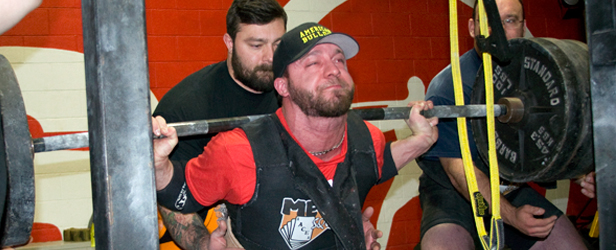
elitefts™ Sunday Edition
Originally Published in Issue 7, The JoshStrength Newsletter
Originally featured in Josh Bryant's newsletter, the following article discusses the concepts of movement intention and Compensatory Acceleration Training (CAT), a training methodology made popular by Fred Hatfield. In his book, Supertraining, Mel Siff explains that "this method refers to the process of deliberately trying to accelerate the bar throughout the concentric phase of the movement, instead of allowing the load alone to determine how one should move." Therefore, not only will an increase in mass (more weight on the bar) cause an increase in muscle tension and resistance, but since force is the product of mass and acceleration (Newton's Second Law), an increase in acceleration will also increase muscle tension and resistance. In other words, adding more weight on the bar isn't the only strategy for breaking a new PR...the intent behind the movement and acceleration can drive you to bigger and better numbers as well.
***
Bodybuilders talk about muscle intention—this means feeling the muscles you are targeting. For example, if you are performing a bicep curl, you feel the biceps do the work. I am going to introduce a concept I call “movement intention.” This simply means that, when performing a core barbell movement on the concentric (positive) portion of the rep, you explode as hard as possible. If lifting a barbell is a war, the Central Nervous System (CNS) is the General that directs your muscles (the soldiers) to accelerate the bar as quickly as possible.
Lifting a submaximal weight with maximal force will provide many of the strength training adaptations of lifting maximal weights. On the same token, lifting a maximal weight with the intent to move it as quickly as possible provides explosive strength benefits. The take home point is that your body adapts, in a large part, to your CNS's intent to move the weight as quickly as possible.
Compensatory Acceleration Training was popularized in the western world by ISSA co-founder, Fred Hatfield. By using this technique for each rep and each set, you can maximize training adaptations. You can half squat more than you can full squat. As leverage improves, you have two options: either accelerate the weight or put on the breaks and ride cruise control. CAT simply means that you compensate improving leverages by accelerating the weight. From a common sense stand point, do you think that you get more out of a workout if you force your muscles to produce maximal force through a partial rep or the whole thing? Regardless of your goal (unless it’s to be weak, small, or slow), it’s the entire range of motion!
A plethora of machine manufacturers have attempted to design machines to compensate for improved leverage. Machines have preset movements patterns, they eliminate stability requirements, and control the resistance and movement speed. Because of the limitations of machines, you severely limit the training benefits your CNS stands to derive.
Fred Hatfield says, “Slamming a weight to the end point in the range of motion certainly would cause injury. The “learning curve” involved in slowing the movement down just before lockout is very small. Anyone can learn how to do it on the first try. It should never be a problem.”
Let’s say that this week you are squatting five sets of four reps in training full range of motion powerlifting squats, using the same weight each set. If you are training like most folks, you come out of the hole forcefully, but as leverage improves, you flip on cruise control and coast to the finish. Training in that manner severely hinders gains, look how:
- Set 1: No squats were heavy enough to stimulate any sort of overload that leads to strength or power gains. Zero out of five reps provided adaptive overload—that’s a 0% efficiency rating.
- Set 2: The bottom half of the last rep required enough intensity to induce some overload. Half the reps produced an adaptive overload—that’s a 10% efficiency rating for true strength gains (.5/5).
- Set 3: The same as Set 2.
- Set 4: The bottom half of the last two squats produced adaptive overload. Two halves equal one whole—this set has an efficiency rating of 20% (1/5).
- Set 5: The bottom half of all five reps produced adaptive overload. Five halves equal two and a half—that's still only a 50% efficiency rating.
Your squat session consisted of 20 total repetitions, and only nine halves produced stimulation for adaptive overload (in other words, actually helped you get stronger). Nine halves is 4.5. So, 4.5 out of 20 is 22.5%—that’s a pretty poor efficiency rating. While people make some gains training this way, they stagnate quickly and are never maximized.
Just think if you squatted the weight for all 20 reps with maximal force?! You’d be a heck of a lot stronger over time. You have to produce force to lift a barbell, and force is mass times acceleration. So, even by lifting submaximal quickly, you can produce maximal force with less weight and less strain on your CNS.
When Dr. Fred Hatfield trained for his world record 1,014-pound squat, he would rarely go above 800 pounds. However, he put more than 1,000 pounds of force on the barbell when he trained!
Since y’all are my dogs, I wanted to share CAT. Give it a try. CAT has one downside, however: the negative acceleration phase, which we will cover next time and how to combat it.










